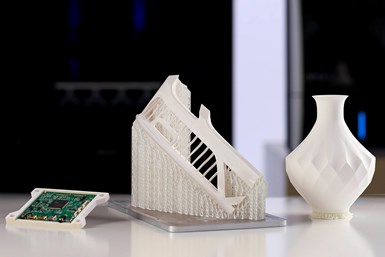Nexa3D Expands Resin Portfolio With Ceramic, Flexible, Clear Materials
Nexa3D worked with material experts at BASF and Henkel to validate custom formulations for its ultrafast fleet of industrial and desktop 3D printers.
Share
Read Next
Nexa3D, a maker of fast, professional and industrial polymer 3D printers, has expanded its high-performance functional resin portfolio with the commercial availability of three new photopolymer resins tailored to address the growing demand for its ultrafast industrial and desktop 3D printers.
The resin portfolio now includes over 20 validated photopolymer materials for both the NXE series and the XiP printer platforms. The company worked with material experts at BASF and Henkel to validate custom formulations for its ultrafast fleet of industrial and desktop 3D printers.
“The addition of three new resins reaffirms our commitment to collaborating with industry’s material experts to continue to formulate and validate high-performing resins that will further expand customer applications that are benefiting from our ultrafast 3D printing technology,” says Kevin McAlea, Nexa3D chief operating officer. “Our expanding range of printers and materials presents a significant upgrade for traditional stereolithography and DLP users with its ultrafast printing speed, high-volume precision and broad range of performance materials that come at the most economical cost of ownership available on the market today.”
The company worked with material experts at BASF to validate the xCERAMIC3280 ceramic composite resin, developed as a fast -printing, rigid material with high heat deflection temperature and excellent tensile modulus. The xCERAMIC3280 resin is well suited for tooling applications as well as wind tunnel testing models.
Through its collaboration with material experts at Henkel, the company developed xMODEL17-Clear, a rigid and durable modeling material with enhanced clarity, well suited for prototyping applications that require fine feature details and high-quality translucent or transparent surface finishes.
Nexa3D also released xFLEX402, a flexible material with firmer shore 76A durometer, high elongation at break and excellent tensile strength, well suited for functional prototyping applications of elastomeric components and production parts.
- Read about Nexa3D choosing Mechnano’s MechT for 3D printing for fabricating high-resolution, static-dissipative parts required in a multitude of electronics applications.
- Learn Nexa3D built 10,000-plus shot molds in hours. With Nexa3D’s polymer process users can print a mold in hours that is prototype or production ready and can last for more than 10,000 shots.
Related Content
-
Lithoz CeraFab System S320 LCM Printer Designed for Efficient, High-Capacity Industrial Serial Production
Formnext 2024: The system offers a build speed of up to 150 layers per hour and layer thickness of 20–200 µm.
-
Foundry Lab: How Casting in a Day Will Improve the Design of Metal Parts (Includes Video)
The company’s digital casting process uses 3D printing, but the result is a cast part. By providing a casting faster than a foundry, the company says effective prototyping is now possible for cast parts, as well as bridge production.
-
MoldJet Technology Enables High-Throughput Metal, Ceramic Additive Manufacturing
Formnext 2023: Tritone Technologies’ additive manufacturing solutions enable industrial throughput of accurate parts with a range of metal and ceramic materials.















